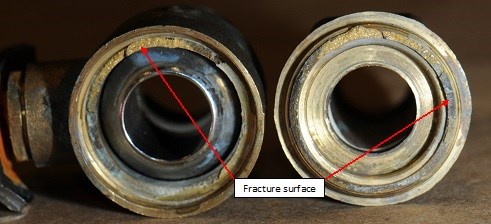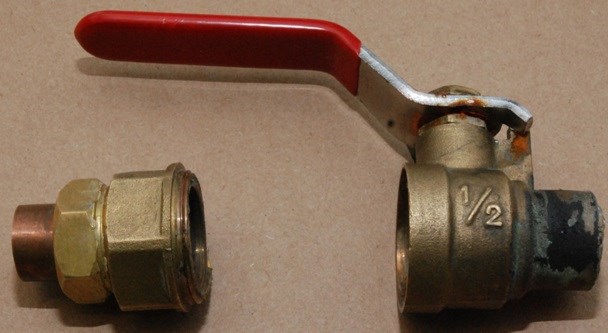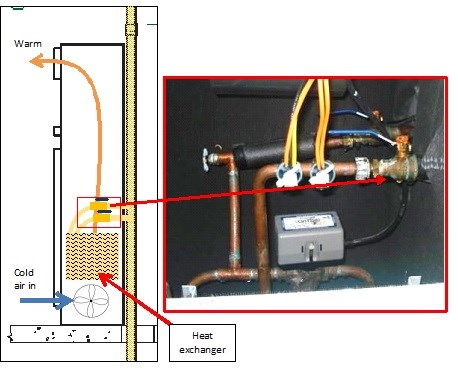Forensic Engineering Tracks Valve Failures
Due in part to the condominium boom, there have been a large number of suite HVAC unit isolation brass ball valve failures reported in fan coil or heat pump based heating/cooling systems high rise buildings.
#materials #ball-butterfly-plug
Over the past five years, in the greater Toronto area of Canada alone, ½ in. brass ball valve failures have resulted in tens of millions of dollars in damages and many resultant lawsuits naming installers, valve manufactures, and HVAC engineers as defendants.
Fan coil units consist of a fan and one or more water-to-air heat exchanger coils that provide heating and/or cooling to the suite. The fan coil heat exchanger coils are fed with hot and/or cold water/glycol from risers which are supplied by the building’s boilers and/or chillers. Similarly, heat pumps are refrigerant-based heating/cooling systems which function by dumping heat into the HVAC risers during cooling mode or by taking heat from the HVAC risers during heating mode.
In heat pump systems, the building’s boilers and chillers maintain a relatively constant temperature in the HVAC system fluid (water or glycol). Both of these systems typically use ½ in. female NPT ball valves to isolate the supply and return lines between the risers and the individual suite HVAC units to allow the units to be serviced without requiring the units in other suites to be shut down (Figure 1).
Figure 1 – Typical fan coil setup with isolating ½ in. brass ball valves
Investigations into the cause of these ball valve failures have generally identified that the ball valves have failed in the male threads between the two halves of the valve (Photographs 1 and 2) resulting in the valve partially or entirely separating into two halves.
Photograph 1 – Failed ½ in. brass ball valve from HVAC system. Valve split at male internal threads
Photograph 2 – The fracture surfaces of a failed ½ in. brass ball valve
Stereomicroscopic examination, electron microscopy, and chemical testing of the valves haveidentified that the mechanism of failure in the vast majority of cases is stress corrosion cracking via dezincification (Photograph3).
Photograph 3 – Stereomicrograph of fracture surface on failed ½ in. brass ball valve
Brass is an alloy of copper and zinc – typically with 35% zinc, approximately 60% copper, and various other minor alloy additions (tin, lead, arsenic, phosphorous). During stress corrosion cracking dezincification of the brass, the alloy dissolves into the corroding solution. Upon dissolution of the alloy,the zinc is carried away by the corroding solution and the more chemically noble copper is re-deposited as a porous weak material on the alloy surface.The brass grain boundaries are attacked preferentially, as the chemical composition of the boundaries is higher in zinc and there are always atomic lattice mismatch stresses at the boundaries which may contribute to a locally higher stress state.The net result of stress corrosion cracking in brass is tight narrow cracks through a high stress region in the brass. For stress corrosion cracking to occur, both a relatively high stress state and a solution capable of causing stress corrosion must be present.
Stress corrosion cracking in brass is generally associated with the presence of ammonia or amine- bearing compounds in the corroding solution.While studies of HVAC systems have not generally identified the source of the ammonia/amines, these compounds may occur due to chloramines from the domestic water used to charge the HVAC systems (cities now generally use chloramines for domestic water treatment). As such, the corroding solutions in HVAC systems typically have compounds which may contribute to the occurrence of stress corrosion cracking.
The vast majority of these ½ in. brass ball valve failures show evidence of excessive stresses generated by over-tightening of the two halves of the ball valve together. Manufacturers generally pre-set the torque to which the two halves are tightened during valve assembly and use a polymeric thread sealant/thread lock to limit further tightening of the threads between the two halves of the body at a later date. This design helps reduce the propensity for stress corrosion cracks to occur in the treads between the two halves of the ball valve by limiting the stresses in the threads.
However, we have investigated circumstances where the two halves of relatively low quality off-shore ball valves were tightened during manufacture to the extent that overload fractures occurred in the threads, and the thread sealant (which is liquid at the time the valve is manufactured but solidifies later) was present on the fracture surfaces. We have also seen a large number of cases where the male NPT fittings threaded into the ball valves (used to connect the valves to the balance of the HVAC system) were excessively over-tightened by careless or untrained installers, causing the thread sealant/lock compound to fail and further tightening of the threads between the two halves of the ball valve to occur. This over-tightening during valve installation leads to excessive stresses in the valve threads and contributes to the occurrence of stress corrosion cracking failures.
As such, the vast majority of these ½ in. brass ball valve failures– and the resulting millions of dollars in property damage and lawsuits - are due to either manufacturing deficiencies in the valves or over-tightening of fittings into the valves by the installing contractor.
The vast majority of brass ball valves are of good quality and most manufactures take care to ensure the internal valve threads are not over-tightened. However, there are always exceptions and care must be taken to ensure valves are purchased from a reputable supplier or manufacturer. Similarly, most plumbers or technicians installing valves do so with care and do not over tighten-threads but, unfortunately, there are always under-trained or careless installers. Where possible, workers should be trained to ensure they understand the degree to which NPT threads should be tightened and the work of novice installers should be inspected for quality and to ensure over-tightening of the ball valve threads has not occurred.
With both manufacturers and installers taking appropriate care and precautions, internal stress corrosion cracking failures of ½ in. brass ball valves can be avoided.
, P.Eng., B.Eng. & Mgmt. is a principal at Giffin Koerth Inc., Canada’s largest forensic engineering firm. Sparling specializes in investigating the causes of piping system failures and works primarily in the defence or support of insurance/legal claims. He has over 15 years of experience in failure analysis. Giffin Koerth Forensic Engineering, 416-368-1700.
RELATED CONTENT
-
Hardfacing for Valves: Materials and Processes
Valve internals, such as seats and closures, are often at risk of erosion, abrasion, corrosion, galling and damage from cavitation.
-
Back to Basics: Globe Valves
There are many applications where the globe valve outshines other designs, so the future is still bright for these long-time favorites of the flow control industry.
-
The Dos and Don’ts of Isolating Pressure Relief Valves
Typically, isolation valves are used to block off a pressure safety valve (PSV) from system pressure, so that maintenance on the valve or related equipment can be conducted without a shut down.















 Unloading large gate valve.jpg;maxWidth=214)